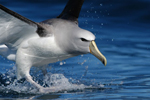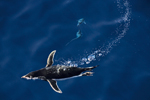Migratory shorebird populations are at great risk from rising sea levels due to global climate change, warns a recent paper in Proceedings of the Royal Society B. These birds play an important role in the distribution of nutrients within wetland and coastal ecosystems, and their loss could have unknown consequences for the rest of the world.
Many scientists have documented the accelerated melting of land ice that had led to higher sea levels, but until now researchers have not known how this would impact shorebirds. But utilizing a mathematical technique that models flow of water through a pipeline, scientists have developed an innovative method to measure the effect habitat loss on shorebirds.
 A Red Knot. Photo by Robert Clemens at University Queensland. |
Millions of shorebirds migrate to more productive and warmer areas to breed annually. The study focuses on the movement of shorebirds from Russian and Alaskan Arctic regions to Southeast Asia and Australia areas, including 10 species: two sub species of bar tailed godwit (Limosa lapponica menzbieri) and (Limosa lapponica baueri), curlew sandpiper (Calidris ferruginea), eastern curlew (Numenius madagascariensis), great knot (Calidris tenuirostris), grey-tailed tattler (Tringa brevipes), lesser sand plover (Charadrius mongolus mongolus) and (Charadrius mongolus stegmanni) combined, two subspecies of red knot (Calidris canutus rogersi) and (Calidris canutus piersmai), and the terek sandpiper (Xenus cinereus) using the East Asian – Australian Flyway (EAAF)
They estimate that sea level rise will flood 23- 40% of intertidal habitat, causing a staggering population loss of up to 70% in some species. The impact of sea level rise is much greater for species where a large proportion of the population stops to refuel and feed at a single site on their journey, known as bottlenecks.

Coastal development in Perth, Australia. Photo by Robert Clemens at University Queensland.
These bottleneck sites “determine the maximum abundance of migratory animals that can be supported by their migratory routes,” explains co-author Dr Takuya Iwamura of Stanford University. He also adds that it is these sites that are “the ones most threatened by recent coastal development in Asia.”
Iwamura explains that areas “in the Yellow Sea (e.g. Bohai bay in China) require immediate attention because these areas mark the location of the biggest bottlenecks in the flyway, yet these habitats are being lost rapidly.” He suggests that “habitat loss through reclamation in places like the Yellow Sea needs to stop, and coastal development should be reconsidered.” As their study shows, “unlimited coastal development greatly threatens the ability of migrants to mitigate the impacts of sea level rise.”

A group of Knot and Godwits some of the species at risk due to sea level rise. Photo by Robert Clemens at University Queensland.
He also adds that “in the longer term, research needs to underpin a strategy to identify what exactly needs to be protected, where, and how in order to achieve conservation goals. International cooperation among many countries in the eastern Pacific is crucial for us to succeed conservation of migratory shorebirds.”
Citation: Takuya Iwamura, Hugh P. Possingham, Iadine Chadès, Clive Minton, Nicholas J. Murray, Danny I. Rogers, Eric A. Treml, and Richard A. Fuller (2013) Migratory connectivity magnifies the consequences of habitat loss from sea-level rise for shorebird populations
Proc R Soc B 280: 20130325
Related articles
Above the ocean: saving the world’s most threatened birds

(11/01/2012) A life on the ocean is a perilous one for any bird. They must expend energy staying aloft for thousands of miles and learn to be marathon swimmers; they must seek food beneath treacherous waves and brave the world’s most extreme climates; they must navigate the perils both of an unforgiving sea and far-flung islands. Yet seabirds, which includes 346 global species that depend on marine ecosystems, have evolved numerous strategies and complex life histories to deal with the challenges of the sea successfully, and they have been doing so since the dinosaur’s last stand. Today, despite such a track record, no other bird family is more threatened; yet it’s not the wild, unpredictable sea that endangers them, but pervasive human impacts.
Cute animal pictures of the day: Humboldt penguin chick meets water
(08/13/2012) Humboldt penguins was found along the western edge of South America in Chile and Argentina. They face a barrage of threats including overfishing, drowning as bycatch, El Nino conditions that affect food availability, and climate change. Significant population declines have led to the species being listed as Vulnerable on the IUCN Red List.
Penguins face a slippery future

(09/26/2012) Penguins have spent years fooling us. With their image seemingly every where we turn—entertaining us in animated films, awing us in documentaries, and winking at us in commercials—they have made most of us believe they are doing just fine; the penguin’s charming demeanor has lulled us into complacency about their fate. But penguin populations are facing historic declines even as their popularity in human society rises. Overfishing is decimating some of their prey species, climate change is shifting their resources and imperiling their habitat, meanwhile pollution, such as oil spills, are putting even healthy colonies at risk. Now, a young organization, the Global Penguin Society (GPS), is working to save all of the world’s 18 penguin species by working with scientists, governments, and local communities.